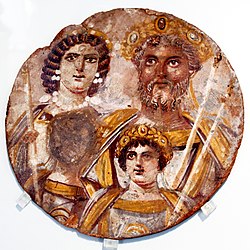
Back Dinastía d'os Severs AN الدولة السويرية Arabic Северы Byelorussian Севери (династия) Bulgarian Dinastia severa Catalan Severovská dynastie Czech Северсен династийӗ CV Severiske dynasti Danish Severer German Δυναστεία των Σεβήρων Greek
| Roman imperial dynasties | ||
|---|---|---|
 | ||
| Severan dynasty | ||
| Chronology | ||
|
193–211 |
||
|
with Caracalla 198–211 |
||
|
with Geta 209–211 |
||
|
211–217 |
||
|
211 |
||
|
Macrinus' usurpation 217–218 |
||
|
with Diadumenian 218 |
||
|
218–222 |
||
|
222–235 |
||
| Dynasty | ||
| Severan dynasty family tree | ||
|
All biographies |
||
| Succession | ||
|
||
The Severan dynasty, sometimes called the Septimian dynasty, ruled the Roman Empire between 193 and 235[1]: 1292 . It was founded by the emperor Septimius Severus (r. 193–211)[1]: 1351 and Julia Domna, his wife, when Septimius emerged victorious from civil war of 193 - 197, which began with the Year of the Five Emperors. Their two sons, Caracalla (r. 192–217)[1]: 211 and Geta (r. 211)[1]: 1350 , ruled briefly after the death of Septimius. In 217 - 218 there was a short interruption of dynasty's control over the empire by reigns of Macrinus (r. 217–218)[1]: 1292 and his son Diadumenian (r. 218) before Julia Domna's relatives assumed power by raising her two grandnephews, Elagabalus (r. 218–222)[1]: 212 and Severus Alexander (r. 222–235)[1]: 212 , in succession to the imperial office[1]: 1292 .
The dynasty's women, Julia Domna, the mother of Caracalla and Geta, and her sister, Julia Maesa, the mother of Julia Soaemias and Julia Mamaea, mothers of Elagabalus and Severus Alexander respectively, were all powerful augustae. They were also instrumental in securing imperial positions for their male relatives.
Although Septimius Severus restored peace following the upheaval of the late 2nd century, the dynasty's rule was disturbed by unstable family relationships and political instability, especially the rising power of the praetorian prefects[2]: 170 . All this foreshadowed the Crisis of the Third Century[3]: 195 .